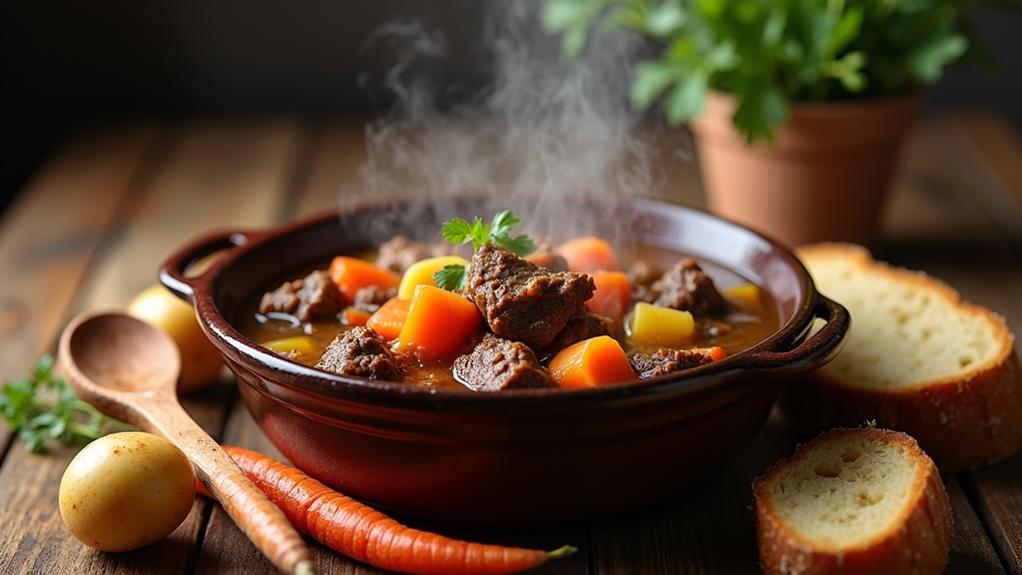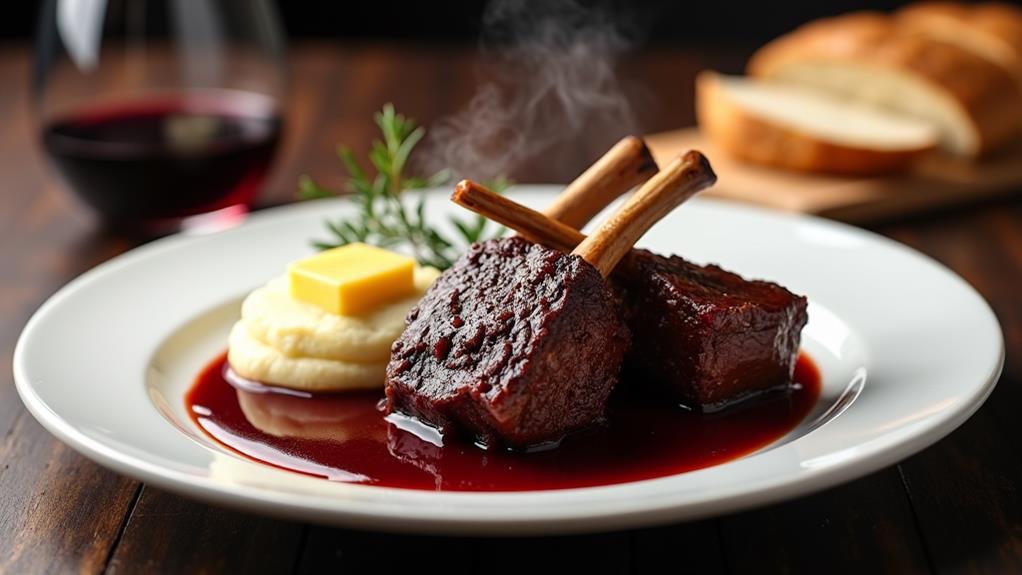Did you know that beef stew has been a staple comfort food for centuries, with variations found in cultures around the world? While the basic concept remains the same, each region has put its own spin on this hearty dish. From the French boeuf bourguignon to the Hungarian goulash, beef stew has evolved to reflect local ingredients and culinary traditions. As you explore the rich history and diverse flavors of this timeless meal, you'll discover why it continues to be a beloved favorite in kitchens everywhere. But what makes the combination of tender beef and root vegetables so irresistible?
Key Takeaways
- Beef chuck is seared to develop rich flavors before simmering with root vegetables like carrots, potatoes, and parsnips.
- The stew is slow-cooked for 2-2.5 hours to achieve tender meat and softened vegetables in a flavorful broth.
- Herbs like bay leaves, thyme, and oregano are added to enhance the stew's depth and aroma.
- A flour slurry can be used to thicken the stew, while Worcestershire sauce and tomato paste boost umami flavors.
- Serve with crusty bread or mashed potatoes for a hearty, comforting meal perfect for cold evenings.
History
Many cultures around the world have their own version of beef stew, with roots tracing back centuries. You'll find that this hearty dish has been a staple in many households, providing warmth and nourishment during cold seasons.
The concept of slow-cooking tough cuts of meat with vegetables in a flavorful liquid has been around for millennia, evolving as culinary techniques and available ingredients changed over time.
In medieval Europe, you'd have seen similar stews called pottage, which were cooked in large cauldrons and often served as a complete meal.
As exploration and trade expanded, new ingredients like potatoes and tomatoes were introduced, further enhancing the stew's flavors and nutritional value.
In America, beef stew gained popularity during the 18th and 19th centuries, becoming a cherished comfort food. You'll notice that regional variations developed, incorporating local ingredients and cooking methods.
Today, you can find countless recipes for beef stew, each reflecting its cultural heritage and the chef's personal touch.
The dish's enduring popularity is a testament to its versatility, nutritional value, and ability to satisfy hunger on a cold day.
Recipe
Hearty beef stew is a classic comfort food that warms the soul and fills the stomach. This rich, flavorful dish combines tender chunks of beef with a medley of vegetables in a savory broth, creating a satisfying meal perfect for cold winter evenings or any time you crave a hearty, home-cooked meal.
This recipe is designed to be simple yet delicious, allowing the natural flavors of the ingredients to shine through. The slow cooking process ensures that the beef becomes incredibly tender, while the vegetables absorb the rich flavors of the broth. With just a few steps and some patience, you'll have a mouthwatering stew that's sure to become a family favorite.
- 2 lbs beef chuck, cut into 1-inch cubes
- 4 medium potatoes, peeled and cubed
- 3 carrots, peeled and sliced
- 2 celery stalks, chopped
- 1 large onion, diced
- 3 cloves garlic, minced
- 2 cups beef broth
- 1 can (14.5 oz) diced tomatoes
- 1/4 cup all-purpose flour
- 2 tbsp vegetable oil
- 1 tsp dried thyme
- 1 tsp dried rosemary
- 2 bay leaves
- Salt and pepper to taste
Heat the oil in a large pot over medium-high heat. Toss the beef cubes with flour, salt, and pepper, then brown them in the pot.
Add onions and garlic, cooking until softened. Pour in the beef broth and diced tomatoes, scraping the bottom of the pot to release any browned bits.
Add the remaining vegetables, herbs, and spices. Bring to a boil, then reduce heat and simmer for 2-3 hours, or until the beef is tender and the vegetables are cooked through.
Remove bay leaves before serving.
For the best results, choose a well-marbled cut of beef, as the fat will melt during cooking, adding flavor and tenderness to the stew.
If you prefer a thicker stew, you can mix 1 tablespoon of cornstarch with 2 tablespoons of cold water and stir it into the stew during the last 15 minutes of cooking.
Don't forget to taste and adjust the seasoning before serving, as the flavors will develop and intensify during the long cooking process.
Cooking Steps
To create a rich and flavorful beef stew, you'll need to follow a series of essential cooking steps.
Begin by searing the beef in hot oil to develop a deep, caramelized flavor, then add your vegetables and broth to build the stew's base.
As the stew simmers on low heat, you'll incorporate herbs and seasonings, finally thickening the mixture with a flour slurry to achieve the perfect consistency.
Step 1. Sear Beef in Hot Oil
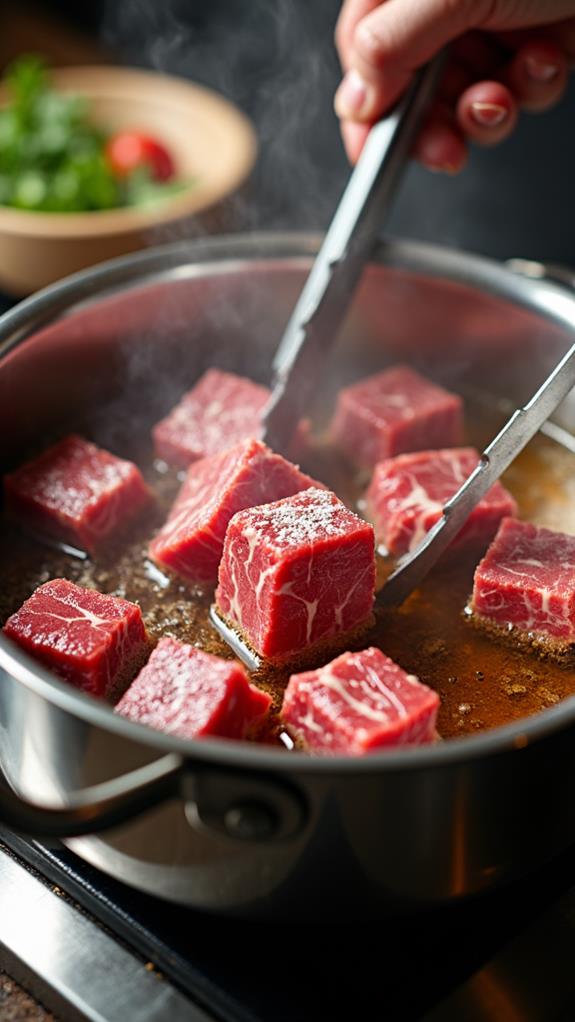
The first crucial step in creating a flavorful beef stew is searing the meat. You'll want to start by heating a large, heavy-bottomed pot over medium-high heat.
Add a generous amount of oil, such as vegetable or canola, and allow it to get very hot. While the oil is heating, pat your beef chunks dry with paper towels to remove excess moisture. This step is crucial, as wet meat won't sear properly.
Once the oil is shimmering and nearly smoking, carefully add the beef in a single layer, making sure not to overcrowd the pot. You'll likely need to work in batches.
Let the meat cook undisturbed for 3-4 minutes on each side, or until it develops a deep brown crust. This process, known as the Maillard reaction, creates complex flavors that will enrich your stew.
Don't be tempted to move the meat around too much; patience is key here. As each batch finishes, remove it from the pot and set it aside.
You'll return the beef to the pot later, where it'll continue to cook and tenderize in the stew's liquid.
Step 2. Add Vegetables and Broth
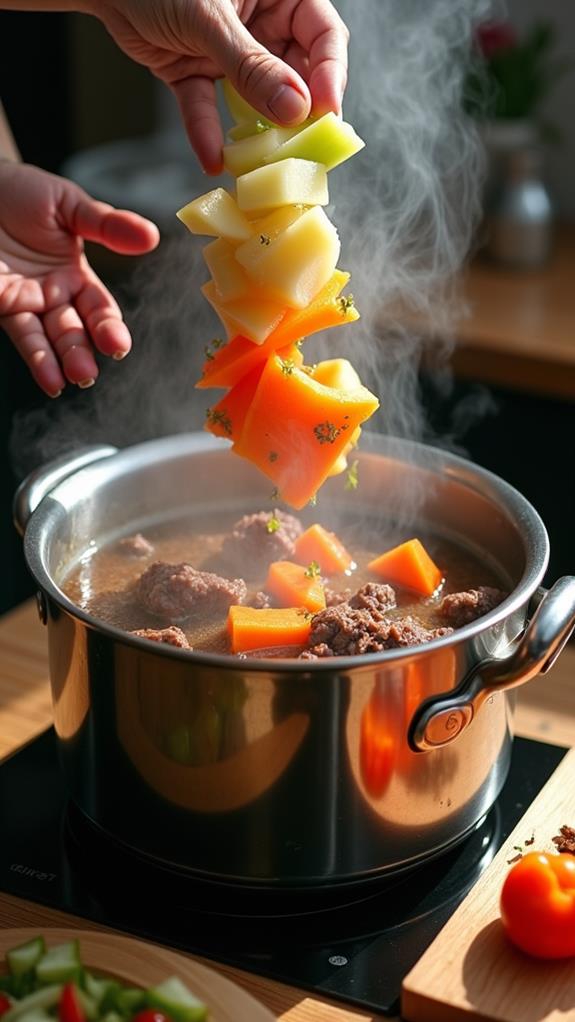
After searing the beef, it's time to build the foundation of your stew. Begin by adding chopped onions to the pot, allowing them to soften and caramelize for about 5 minutes. This process will release their natural sweetness, enhancing the overall flavor profile of your stew.
Next, introduce minced garlic, stirring it into the onions for an additional minute until fragrant.
Now, it's time to incorporate your root vegetables. Add cubed carrots, parsnips, and potatoes to the pot, stirring them to coat with the flavorful pan drippings. These hearty vegetables will provide substance and depth to your stew.
Pour in beef broth, ensuring it covers the vegetables and meat completely. For added richness, you can include a cup of red wine at this stage.
Bring the mixture to a gentle simmer, then reduce the heat to low. Cover the pot and let it cook slowly, allowing the flavors to meld and the meat to become tender. This slow-cooking process is crucial for developing the stew's characteristic robust taste and comforting texture.
Step 3. Simmer on Low Heat

Simmer time is crucial for developing your stew's rich flavors and tender texture. Once you've added all ingredients, bring the pot to a gentle boil, then reduce the heat to low. Cover the pot and let it simmer for about 2 to 2 1/2 hours, stirring occasionally to prevent sticking.
During this time, the beef will become incredibly tender, and the vegetables will soften, releasing their flavors into the broth. As the stew simmers, you'll notice the liquid reducing and thickening. This concentration of flavors is key to a delicious final product.
If the stew becomes too thick, you can add a little more broth or water. Conversely, if it's too thin, you can remove the lid for the last 30 minutes of cooking to allow excess liquid to evaporate. Taste the stew periodically and adjust the seasoning as needed.
The low, slow cooking process allows the flavors to meld beautifully, creating a hearty, comforting dish that's perfect for cold days. Remember, patience is essential – don't rush the simmering process, as it's what transforms simple ingredients into a memorable meal.
Step 4. Add Herbs and Seasonings
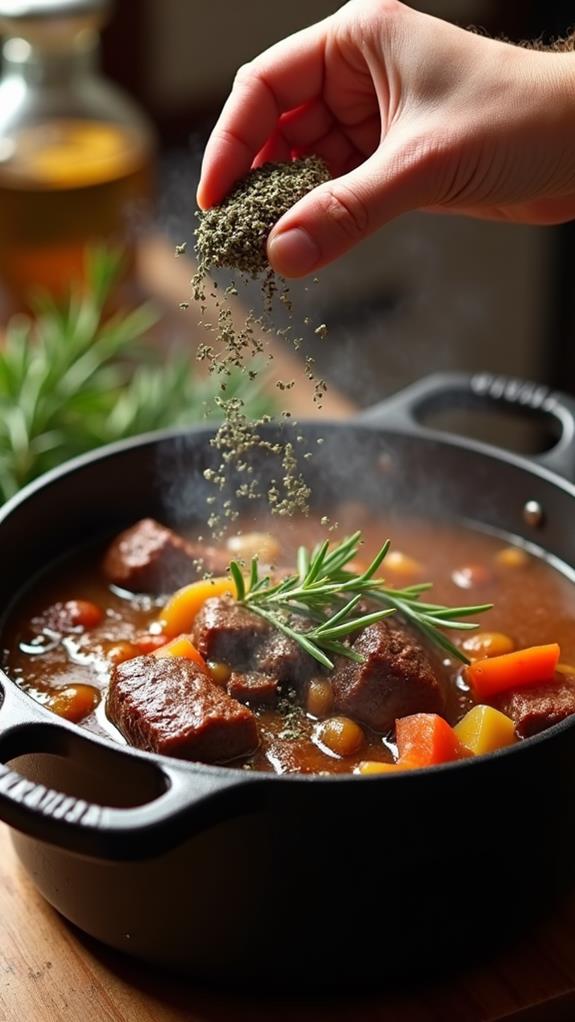
Herbs and seasonings are the soul of a hearty beef stew, elevating its flavor profile from good to great. As your stew simmers, it's time to add these essential ingredients. Start with a bay leaf or two, which will infuse the broth with a subtle, earthy flavor.
Next, introduce some fresh thyme sprigs; their aromatic essence will complement the rich beef beautifully. Don't forget to add a generous pinch of dried oregano for its slightly bitter, pungent notes.
For depth and warmth, sprinkle in some paprika and a dash of ground cumin. These spices will enhance the overall complexity of your stew. Season with salt and freshly ground black pepper to taste, but be cautious not to oversalt, as the flavors will concentrate as the stew cooks.
If you're feeling adventurous, add a splash of Worcestershire sauce for umami or a tablespoon of tomato paste for acidity and color. Remember, you can always adjust the seasonings later, so start conservatively and taste as you go.
With these herbs and spices, your beef stew will transform into a comforting, flavorful masterpiece that'll warm you from the inside out.
Step 5. Thicken With Flour Slurry
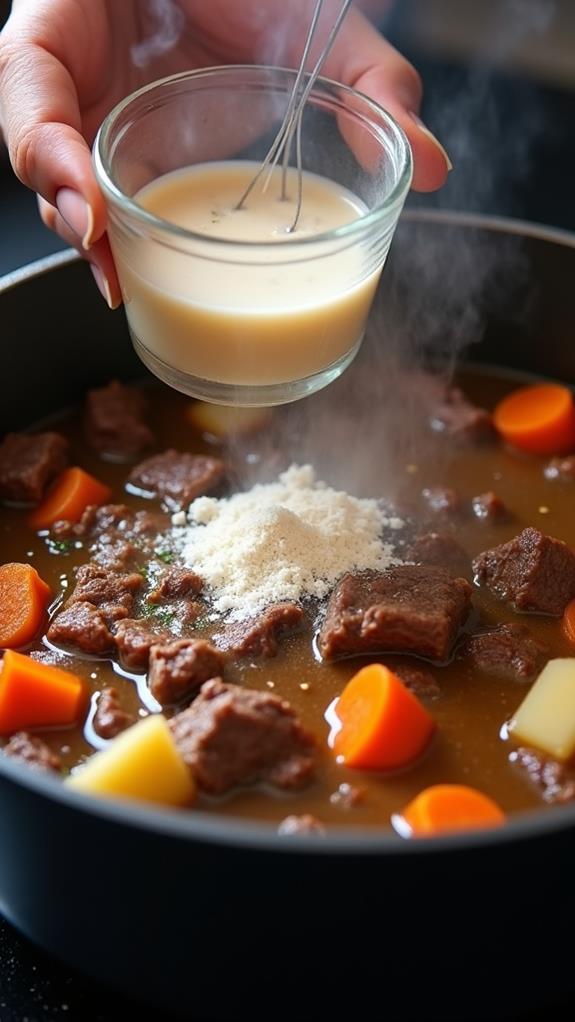
Now that your stew is infused with aromatic herbs and spices, it's time to give it the perfect consistency. To thicken your beef stew, you'll need to create a flour slurry. In a small bowl, whisk together equal parts all-purpose flour and cold water until smooth. Start with about 2 tablespoons of each, adjusting as needed based on the amount of liquid in your stew.
Slowly pour the slurry into the simmering stew, stirring constantly to prevent lumps from forming. The heat will activate the flour's thickening properties, gradually increasing the stew's viscosity. Continue cooking for at least 5 minutes to ensure the raw flour taste cooks out.
If you find the stew isn't thick enough, you can repeat the process with additional slurry. Remember, the stew will continue to thicken as it cools, so don't overdo it.
For a gluten-free alternative, you can use cornstarch instead of flour, following the same method. This technique will transform your hearty beef stew into a rich, comforting meal with the ideal consistency to coat your spoon and satisfy your taste buds.
Final Thoughts
This hearty beef stew's comforting warmth and rich flavors make it a perfect meal for cold evenings. As you've learned, creating this classic dish requires patience and attention to detail, but the results are well worth the effort.
Remember, the key to a successful stew lies in properly browning the meat, selecting the right combination of vegetables, and allowing ample time for the flavors to meld together.
Don't hesitate to experiment with different root vegetables or herbs to tailor the stew to your taste preferences. You can also adjust the consistency by adding more liquid or thickening the gravy as desired.
Serve your stew with crusty bread or over mashed potatoes for a complete and satisfying meal.
Leftovers can be stored in the refrigerator for up to three days or frozen for future enjoyment. In fact, many find that the flavors intensify after a day or two, making this stew an excellent make-ahead option for busy weeknights or entertaining guests.
With practice, you'll soon master this versatile and beloved comfort food, creating a dish that's sure to become a family favorite.

